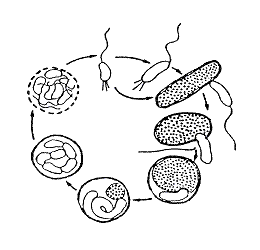Bdellovibrio
| Bdellovibrio | ||||||||||||
|---|---|---|---|---|---|---|---|---|---|---|---|---|

Bdellovibrio cycle |
||||||||||||
| Systematics | ||||||||||||
|
||||||||||||
| Scientific name | ||||||||||||
| Bdellovibrio | ||||||||||||
| Stolp & Starr 1963 | ||||||||||||
| species | ||||||||||||
Bdellovibrio is a genus of bacteria that includes very small, very fast swimming, gram-negative , aerobic , bacteria-parasitic species.
The Bdellovibrien are monopolar monotrich flagellated and swim at a speed of 100 times their body length per second. They mostly attack gram-negative bacteria , preferably Pseudomonas and Enterobacteria .
Bdellovibrio was discovered by Heinz Stolp in 1962 .
Life cycle
The free-swimming individuals of Bdellovibrio attach themselves to the cell wall of their victims, penetrate the cell wall, invade the periplasmic space , and then digest their host's cytoplasm . After multiplication through cell division, the offspring are released into the open by dissolving the host's cell wall .
The capture of host bacteria is facilitated by the fact that the Bdellovibrionen can swim particularly quickly. This is achieved because they have a thicker flagella compared to "normal" bacterial flagella. This allows for a stronger push when moving. In connection with the small size of the Bdellovibrionen, very high speeds are achieved in this way, so that they can easily reach their prey bacteria. The shape of the flagellum is also unusual: the section close to the body has a greater spiral height than the section further away from the body.
Once the parasites have reached their prey, they attach themselves firmly to its surface and, with the help of their strong flagellum, perform rapid turning movements, which were interpreted as “drilling”. It is not certain whether mechanical influences actually contribute to the penetration of the prey bacterium. B. bacteriovorus presumably releases a mixture of hydrolytic enzymes that open the cell wall in a localized manner and allow the intruder to slip into the prey's periplasm . The resulting hole is then completely closed again. In the periplasm, the intruders break down the macromolecules in the prey's cytoplasm with the help of many hydrolytic enzymes and a large number of different transport complexes and use them as a substrate (as nutrients) for their own growth. The parasites grow into a cylinder inside the host , from which many new, single-celled individuals of the same size arise through cell division and constriction . After cell division and maturation, the prey bacteria are completely destroyed - again by attack by hydrolytic enzymes - and at the same time a mostly uneven number of new B. bacteriovorus individuals is released.
Genome research
In 2004 , S. Schuster and colleagues published the base sequence of the complete genome of B. bacteriovorus . They compare the data derived from the base sequence with the life cycle of B. bacteriovorus and succeed in showing how this is reflected in the genomic makeup of the bacterium. For all eight different phases of the life cycle (perception of the prey - attachment - penetration - settling in - formation of the bdelloplast - cell division - maturation - release) genes and proteins could be identified that presumably play a decisive role in the respective phase. In this way, genes for the formation of the flagella and various adhesive structures were identified that are likely to be involved in the first two phases.
Individual evidence
- ^ A b Jean Euzéby, Aidan C. Parte: Genus Bdellovibrio. In: List of Prokaryotic names with Standing in Nomenclature ( LPSN ). Retrieved August 8, 2014 .
literature
Snjezana Rendulic, Pratik Jagtap, Andrea Rosinus, Mark Eppinger, Claudia Baar, Christa Lanz, Heike Keller, Carey Lambert, Katy J. Evans, Alexander Goesmann, Folker Meyer, R. Elizabeth Sockett, Stephan C. Schuster: A Predator Unmasked: Life Cycle of Bdellovibrio bacteriovorus from a Genomic Perspective In: Science . Vol. 303, pp. 689-692.